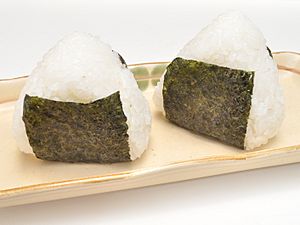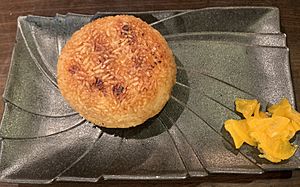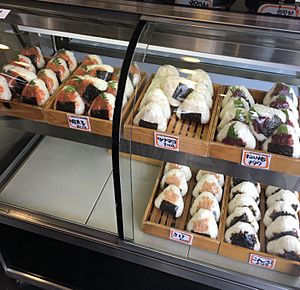Onigiri facts for kids

Two onigiri, or rice balls, on a plate
|
|
| Type | Rice balls |
|---|---|
| Place of origin | Japan |
| Associated national cuisine | |
| Main ingredients | Japonica rice |
| Similar dishes | Arancini, cifantuan, jumeok-bap, zongzi |

Onigiri (お握り), also known as omusubi or rice ball, is a popular Japanese food. It is made from white rice shaped into triangles or cylinders. Often, it is wrapped in nori (seaweed).
Traditionally, onigiri has fillings like pickled plum (umeboshi), salted salmon, or dried bonito flakes (katsuobushi). These fillings helped keep the rice fresh. Today, you can find many different kinds of onigiri. Japanese convenience stores sell them with lots of flavors. There are even special shops just for onigiri. This tasty snack is now popular in Japanese restaurants all over the world.
It's important not to confuse onigiri with sushi. Onigiri is made with plain rice, sometimes lightly salted. Sushi, however, uses rice mixed with vinegar, sugar, and salt. Onigiri was created to make rice easy to carry and eat. Sushi was first a way to preserve fish.
Contents
The History of Onigiri

Onigiri has a long history in Japan. In the 11th century, a writer named Murasaki Shikibu wrote about people eating rice balls. Her diary, The Diary of Lady Murasaki, mentions these rice balls. Back then, they were called tonjiki and were often eaten at outdoor picnics.
Even earlier, in the Nara period, people rolled rice into small balls. This made it easy to pick up and eat before chopsticks were common. During the Heian period, rice was shaped into small rectangles. These tonjiki could be stacked on a plate and eaten easily.
From the Kamakura period to the early Edo period, onigiri was a quick meal for many. Samurai often carried rice balls wrapped in bamboo leaves. This gave them a fast lunch during wars. These early onigiri were simple rice balls flavored with salt. Nori (seaweed) did not become widely available until the mid-Edo period. That's when people started farming nori and making it into sheets.
How Onigiri is Made Today
In the 1980s, a machine was invented to make triangular onigiri. Instead of rolling the filling inside, the machine put the flavor into a hole in the rice ball. This hole was then covered by nori. At first, the nori would get moist and sticky because it was already on the rice.
Later, new packaging was created. This packaging kept the nori separate from the rice. Before eating, you could open the packet and wrap the nori around the onigiri yourself. This kept the nori crispy. The hole for the filling also made it easier to create new flavors. Modern onigiri packaging is designed so that plastic keeps the nori and rice apart. When you pull the packaging open, the nori and rice come together.
Different Kinds of Onigiri
Onigiri is usually made with boiled white rice. But sometimes, other types of cooked rice are used, such as:
- O-kowa or kowa-meshi: This is sticky rice cooked with vegetables, like red beans.
- Maze-gohan: This means "mixed rice." It's cooked rice mixed with different ingredients.
- Fried rice: Sometimes, onigiri is made with fried rice.

Popular Onigiri Fillings
Many different ingredients are used to fill onigiri. If the rice itself is already seasoned, it usually doesn't have a filling. Plain onigiri, made only with salt, is called shio-musubi.
Here are some common fillings:
- Dressed dishes: Like tuna mixed with mayonnaise, or shrimp with mayonnaise.
- Dried fish: Such as roasted and crumbled mackerel or Japanese horse mackerel.
- Processed roe: This includes mentaiko (spicy cod roe) or tarako (salted cod roe).
- Tsukudani: Small seafood or seaweed cooked in soy sauce and sugar.
- Pickled fruits and vegetables: Such as umeboshi (pickled plum) or takana (pickled mustard greens).
Local Onigiri Styles
Some regions in Japan have their own special onigiri.
- Miso-onigiri: Popular in eastern Japan. It uses miso paste as a filling. Sometimes, miso is mixed with green onion. It can also be spread on the outside and roasted, like a type of Yaki-onigiri.
- Tenmusu: This onigiri originally came from Tsu, Mie. It became famous as a Nagoya cuisine. It usually has a tempura shrimp inside.
- Pork-tamago-onigiri: Found in Okinawa. This onigiri is filled with Lunch meat and fried egg.
See also
 In Spanish: Onigiri para niños
In Spanish: Onigiri para niños

